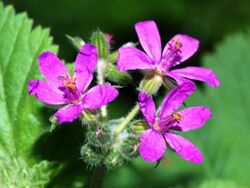Biology:Erodium
| Erodium | |
|---|---|

| |
| Erodium malacoides | |
| Scientific classification | |
| Kingdom: | Plantae |
| Clade: | Tracheophytes |
| Clade: | Angiosperms |
| Clade: | Eudicots |
| Clade: | Rosids |
| Order: | Geraniales |
| Family: | Geraniaceae |
| Genus: | Erodium Aiton |
| Species | |
|
See text | |
| Synonyms | |
| |
Erodium is a genus of flowering plants in the botanical family Geraniaceae. The genus includes about 60 species, native to North Africa, Indomalaya, the Middle East, and Australia . They are perennials, annuals, or subshrubs, with five-petalled flowers in shades of white, pink, and purple, that strongly resemble the better-known Geranium (cranesbill).[1] Cultivated plants are known as filarees or heron's bill in North America, whereas in the British Isles they are usually called storksbills.
Taxonomy
Carl Linnaeus grouped in the same genus (Geranium), the three similar genera Erodium, Geranium, and Pelargonium. The distinction between them was made by Charles Louis L'Héritier de Brutelle based on the number of stamens or anthers: five for Erodium,[2] seven for Pelargonium, and ten for Geranium.[2] However, the three genera have the same characteristics in regard to their fruit, which resemble long bird beaks. That characteristic is the basis for the names: Geranium evokes the crane (Greek geranos), Pelargonium the stork (pelargos), and Erodium the heron (erodios).
Cultivation
In cultivation, erodiums are usually seen in rockeries or alpine gardens.[1]
The hybrid cultivar E. × variabile 'Roseum' (E. corsicum × E. reichardii), a compact, spreading perennial with rose-pink flowers in summer, has gained the Royal Horticultural Society's Award of Garden Merit.[3]
Ecology
Erodium species are used as food plants by the larvae of some Lepidoptera species including the pasture day moth.
Species
(As of July 2020), the World Checklist of Selected Plant Families accepts 119 species:[4]
Hybrids include:
- Erodium × anaristatum Andreas
- Erodium × bolosii Romo
- Erodium × fallax Jord.
- Erodium × viscosum Salzm. ex Delile
Uses
Species such as E. cicutarium and E. moschatum are edible.[5]
See also
References
- ↑ 1.0 1.1 RHS A-Z encyclopedia of garden plants. United Kingdom: Dorling Kindersley. 2008. pp. 1136. ISBN 978-1405332965.
- ↑ 2.0 2.1 Parnell, J. and Curtis. Webb's An Irish Flora. Cork University Press. ISBN:978-185918-4783
- ↑ "Erodium × variabile 'Roseum'". Royal Horticultural Society. https://www.rhs.org.uk/Plants/81968/Erodium-x-variabile-Roseum/Details.
- ↑ "Erodium L'Hér. ex Aiton" (in en). https://powo.science.kew.org/taxon/urn:lsid:ipni.org:names:30013005-2.
- ↑ Nyerges, Christopher (2016). Foraging Wild Edible Plants of North America: More than 150 Delicious Recipes Using Nature's Edibles. Rowman & Littlefield. p. 81. ISBN 978-1-4930-1499-6. https://books.google.com/books?id=RwDHCgAAQBAJ.
Further reading
- Pink, A. (2004). Gardening for the Million. Project Gutenberg Literary Archive Foundation. https://www.gutenberg.org/ebooks/11892.
Wikidata ☰ Q162920 entry
 |



